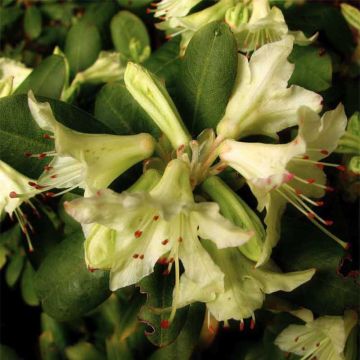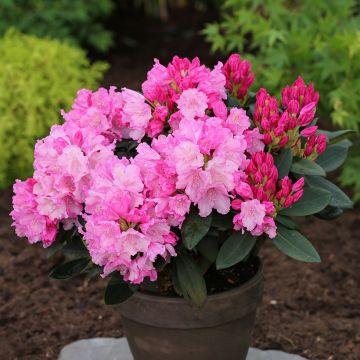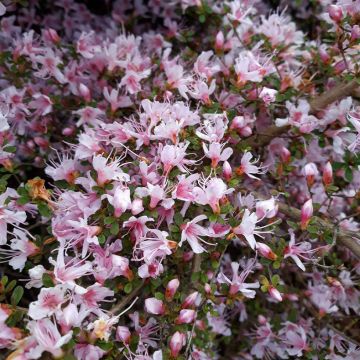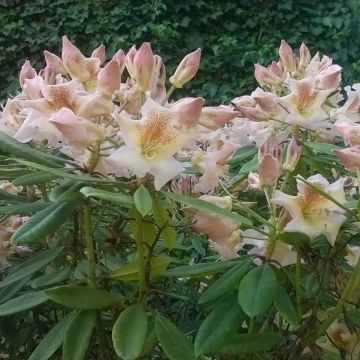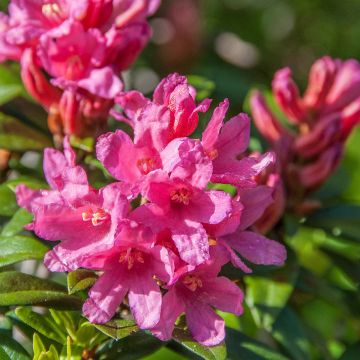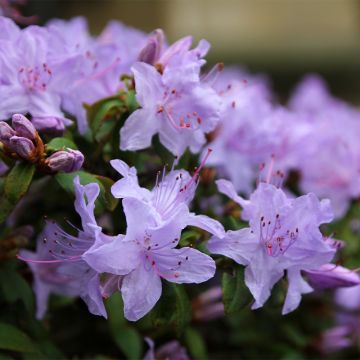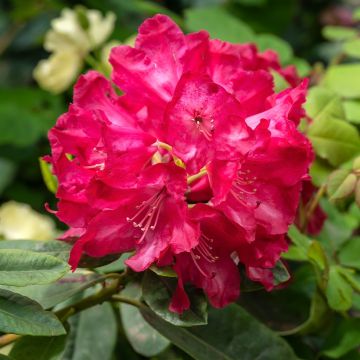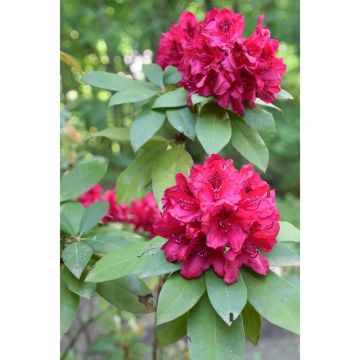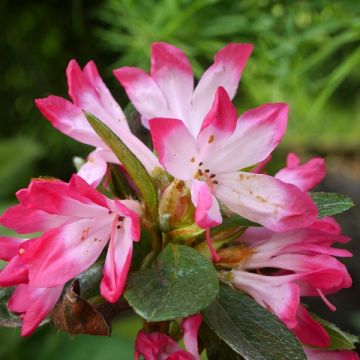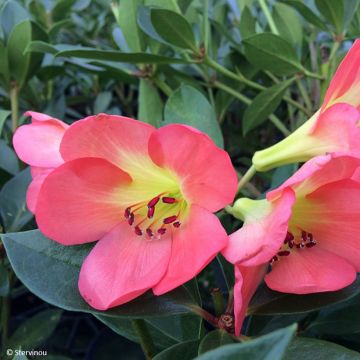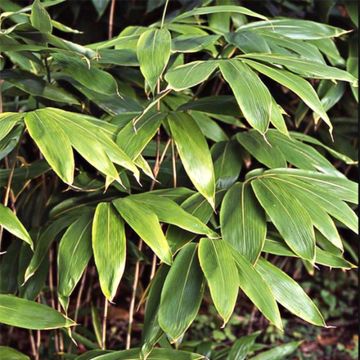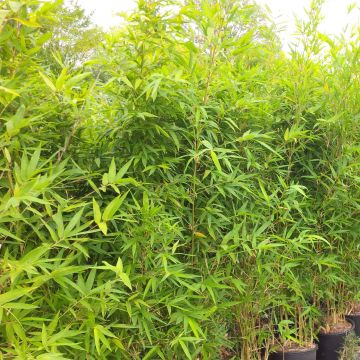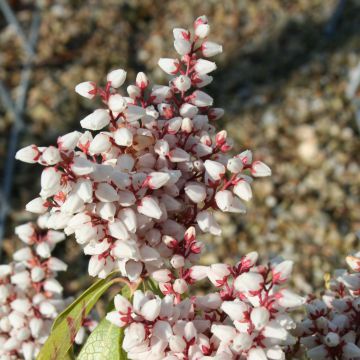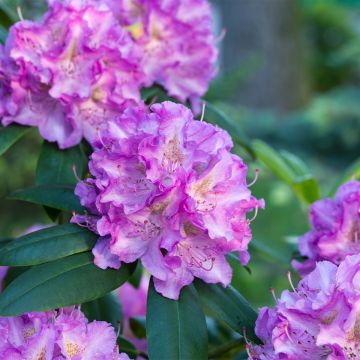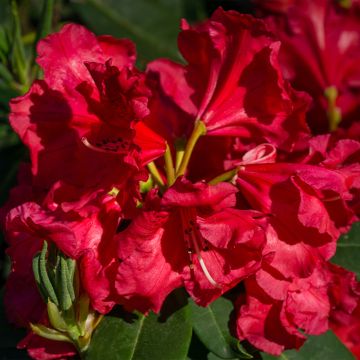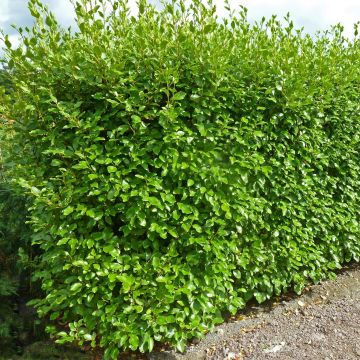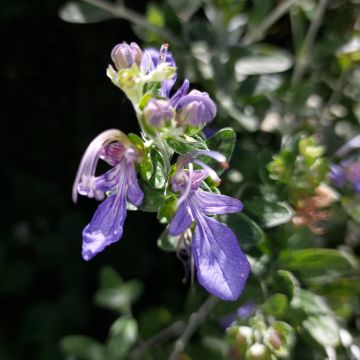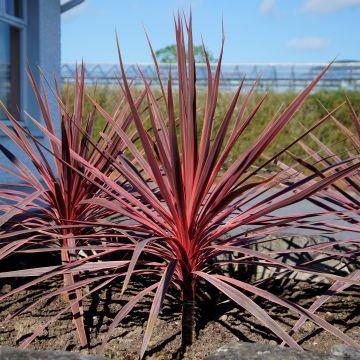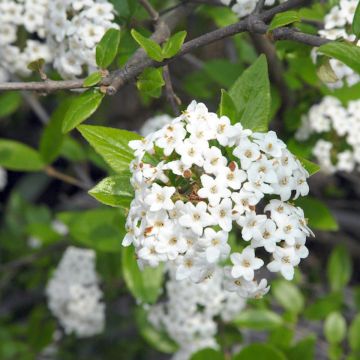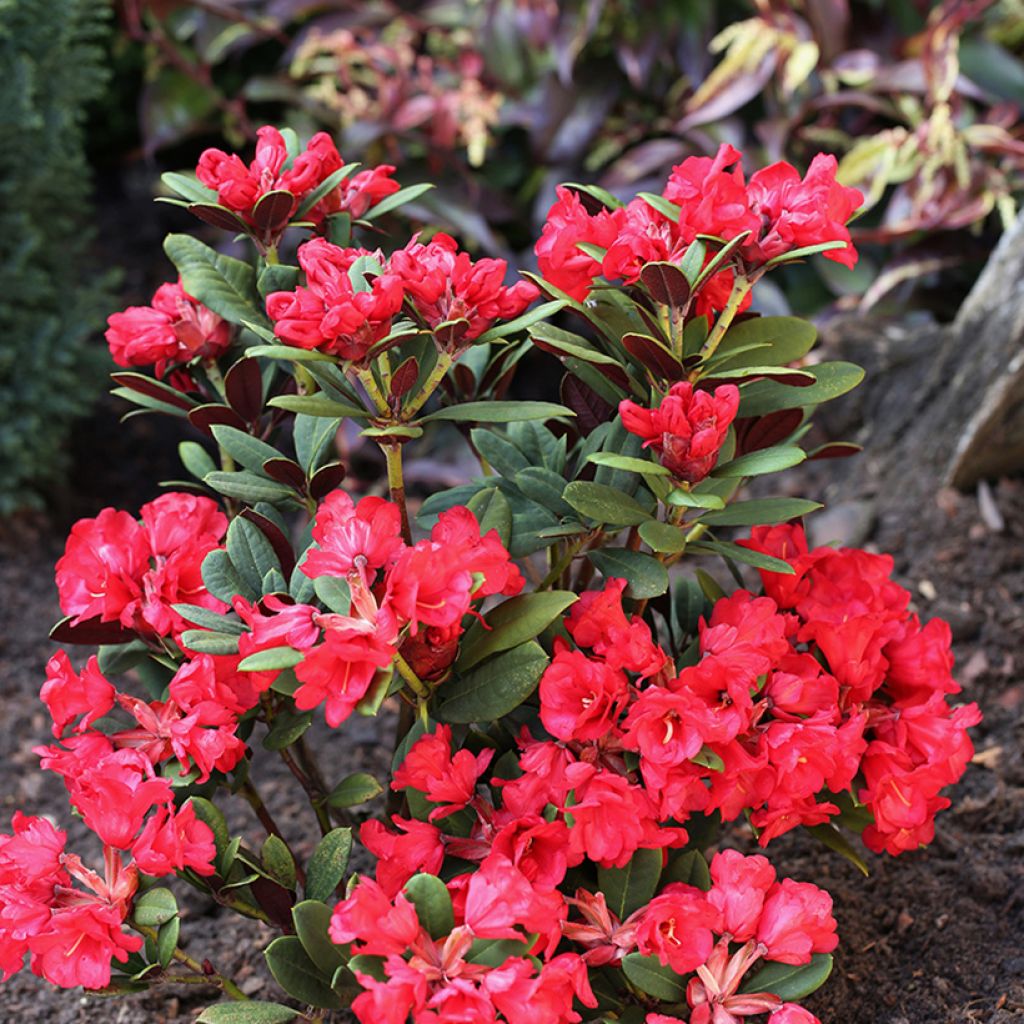

Rhododendron Burletta
Rhododendron Burletta
Rhododendron neriiflorum Burletta
This item cannot be shipped to the selected country
Delivery charge from €5.90
More information
Schedule delivery date,
and select date in basket
This plant carries a 24 months recovery warranty
More information
We guarantee the quality of our plants for a full growing cycle, and will replace at our expense any plant that fails to recover under normal climatic and planting conditions.
From €5.90 for pickup delivery and €6.90 for home delivery
Express home delivery from €8.90.
Does this plant fit my garden?
Set up your Plantfit profile →
Description
Rhododendron 'Burletta' is a delightful compact variety with slow growth, perfectly suited for small gardens or container gardening. Ornamental both in terms of its flowering and foliage, it produces an abundance of trumpet-shaped, bright red flowers in spring, eye-catching in the garden. The evergreen leaves are dark green on top and dark red-purple underneath and remain decorative throughout the year. It is sensitive to limestone and drought. It thrives in acidic, humus-bearing, moist soil and light shade, and can be grown in containers.
Rhododendrons are members of the Ericaceae family, which includes many ornamental genera. Rhododendron neriiflorum is native to China, Tibet, and Myanmar (Burma). This species forms a medium-sized bush, ranging from 1.50m to 2m and more, with decorative bark. Growing at altitudes of 2000 to 3500m, it produces red flowers and has lanceolate to elliptical leaves (more or less elongated and narrow in shape).
The horticultural variety 'Burletta' was developed by the German breeder Hans Hachmann, who obtained it in 1994. More compact than the species, with slow growth, 'Burletta' eventually forms a bush 55 to 75cm in height, with a spread of 90cm to 1.30m. This small spreading bush has particularly ornamental evergreen foliage. The elliptical leaves, mucronate (slightly pointed at the tip), are relatively small, measuring about 5 to 8cm in length and 2 to 4cm in width. Arranged alternately on the branches, they are carried by petioles of 1.5 to 2.5cm. They are easily recognisable by their dual colouring, a beautiful glossy dark green on the upper side, and a surprising dark reddish-purple, tending towards burgundy red on the lower side. This uniqueness gives the foliage a distinctive and ornamental character.
Around mid-April, sometimes earlier depending on the year, campanulate flowers appear, in the form of open trumpets, measuring 5cm in diameter and grouped in clusters of 5 to 10 or 12 at the ends of the branches. Blooming for approximately 3 weeks, their bright red colour against the dark backdrop of the foliage creates a beautiful scene.
Hardy down to -20°C/-22°C, this Rhododendron can be slightly sensitive to frost when placed in poor growing conditions.
Rhododendron 'Burletta' is a true gem for the garden. While many varieties are mainly valued for their flowering, it adds the interest of truly decorative foliage. You can easily integrate it into a bed of acid-loving plants alongside other ornamental bushes that will allow you to enjoy stunning blooms throughout the seasons. Camellias offer an incredible choice of flowers with multiple patterns and colours, blooming in autumn (Camellia sasanqua) and winter. As spring approaches, the large white star-shaped blooms of Magnolia stellata will make a big impression, preceding the red fireworks of 'Burletta'. Cornus kousa Cappuccino, a Japanese Dogwood with foliage that varies with the seasons, will bridge the gap to summer with its large white bracts as graceful as butterflies, followed by highly decorative fuchsia pink berries. And for summer, Hydrangeas, available in various species and varieties, will offer you an abundance of flowers.
Report an error about the product description
Plant habit
Flowering
Foliage
Botanical data
Rhododendron
neriiflorum
Burletta
Ericaceae
Cultivar or hybrid
Other Small Rhododendron
Planting and care
Plant Rhododendron 'Burletta' in a sunny north-facing exposure or a partially shaded south-facing exposure, protected from cold and drying winds, in a humus-bearing, light soil with a tendency towards acidity (pH between 4.5 and 6). The soil should never dry out, but should not be waterlogged either. This variety does not tolerate heat or dry atmospheres, it thrives in a cool, humid climate. Like all acid soil plants, this Rhododendron does not tolerate limestone soils, nor heavy soils that are waterlogged in winter. If the soil remains moist in summer, this rhododendron can also tolerate exposure to non-scorching sunlight.
Dig a hole three times larger than the pot. Soak the root ball in non-limestone water for fifteen minutes to ensure thorough saturation, and plant the bush without burying it (the soil level should be at the collar), in a mix composed of 1/4 ericaceous soil, leaf compost, gravel or pumice, and loam. Water generously and keep the soil moist in summer. Azaleas and Rhododendrons have a shallow root system, which makes them susceptible to prolonged dry periods. Therefore, it is recommended to enrich the soil with humus and to water abundantly during dry periods. Additionally, their root system is not very strong, which is why it is essential to lighten heavy soils with draining materials (gravel, pumice, clay pebbles) at planting. Apply a mulch of shredded pine bark around the base of the bush every spring to maintain soil moisture while preserving an acidic pH.
This 'Burletta' variety is sensitive to excessive fertilisation, so only use low-concentration organic fertilisers if your soil is somewhat poor, otherwise do not feed at all.
Maintenance consists of removing faded flowers in summer and pruning dead branches. Azaleas and Rhododendrons can sometimes be attacked by vine weevils, which eat the edges of leaves and rootlets, as well as the notorious 'rhododendron beetle', which rarely causes significant damage. Effective organic solutions are now available to combat vine weevils. Yellowing of leaves (chlorosis) in Rhododendrons indicates poor iron assimilation in the soil and can lead to premature plant death. While limestone (in the soil or irrigation water) is usually the cause, poorly-drained soil or deeply planted root balls can also explain this phenomenon.
Planting period
Intended location
Care
This item has not been reviewed yet - be the first to leave a review about it.
Evergreen shrubs
Haven't found what you were looking for?
Hardiness is the lowest winter temperature a plant can endure without suffering serious damage or even dying. However, hardiness is affected by location (a sheltered area, such as a patio), protection (winter cover) and soil type (hardiness is improved by well-drained soil).

Photo Sharing Terms & Conditions
In order to encourage gardeners to interact and share their experiences, Promesse de fleurs offers various media enabling content to be uploaded onto its Site - in particular via the ‘Photo sharing’ module.
The User agrees to refrain from:
- Posting any content that is illegal, prejudicial, insulting, racist, inciteful to hatred, revisionist, contrary to public decency, that infringes on privacy or on the privacy rights of third parties, in particular the publicity rights of persons and goods, intellectual property rights, or the right to privacy.
- Submitting content on behalf of a third party;
- Impersonate the identity of a third party and/or publish any personal information about a third party;
In general, the User undertakes to refrain from any unethical behaviour.
All Content (in particular text, comments, files, images, photos, videos, creative works, etc.), which may be subject to property or intellectual property rights, image or other private rights, shall remain the property of the User, subject to the limited rights granted by the terms of the licence granted by Promesse de fleurs as stated below. Users are at liberty to publish or not to publish such Content on the Site, notably via the ‘Photo Sharing’ facility, and accept that this Content shall be made public and freely accessible, notably on the Internet.
Users further acknowledge, undertake to have ,and guarantee that they hold all necessary rights and permissions to publish such material on the Site, in particular with regard to the legislation in force pertaining to any privacy, property, intellectual property, image, or contractual rights, or rights of any other nature. By publishing such Content on the Site, Users acknowledge accepting full liability as publishers of the Content within the meaning of the law, and grant Promesse de fleurs, free of charge, an inclusive, worldwide licence for the said Content for the entire duration of its publication, including all reproduction, representation, up/downloading, displaying, performing, transmission, and storage rights.
Users also grant permission for their name to be linked to the Content and accept that this link may not always be made available.
By engaging in posting material, Users consent to their Content becoming automatically accessible on the Internet, in particular on other sites and/or blogs and/or web pages of the Promesse de fleurs site, including in particular social pages and the Promesse de fleurs catalogue.
Users may secure the removal of entrusted content free of charge by issuing a simple request via our contact form.
The flowering period indicated on our website applies to countries and regions located in USDA zone 8 (France, the United Kingdom, Ireland, the Netherlands, etc.)
It will vary according to where you live:
- In zones 9 to 10 (Italy, Spain, Greece, etc.), flowering will occur about 2 to 4 weeks earlier.
- In zones 6 to 7 (Germany, Poland, Slovenia, and lower mountainous regions), flowering will be delayed by 2 to 3 weeks.
- In zone 5 (Central Europe, Scandinavia), blooming will be delayed by 3 to 5 weeks.
In temperate climates, pruning of spring-flowering shrubs (forsythia, spireas, etc.) should be done just after flowering.
Pruning of summer-flowering shrubs (Indian Lilac, Perovskia, etc.) can be done in winter or spring.
In cold regions as well as with frost-sensitive plants, avoid pruning too early when severe frosts may still occur.
The planting period indicated on our website applies to countries and regions located in USDA zone 8 (France, United Kingdom, Ireland, Netherlands).
It will vary according to where you live:
- In Mediterranean zones (Marseille, Madrid, Milan, etc.), autumn and winter are the best planting periods.
- In continental zones (Strasbourg, Munich, Vienna, etc.), delay planting by 2 to 3 weeks in spring and bring it forward by 2 to 4 weeks in autumn.
- In mountainous regions (the Alps, Pyrenees, Carpathians, etc.), it is best to plant in late spring (May-June) or late summer (August-September).
The harvesting period indicated on our website applies to countries and regions in USDA zone 8 (France, England, Ireland, the Netherlands).
In colder areas (Scandinavia, Poland, Austria...) fruit and vegetable harvests are likely to be delayed by 3-4 weeks.
In warmer areas (Italy, Spain, Greece, etc.), harvesting will probably take place earlier, depending on weather conditions.
The sowing periods indicated on our website apply to countries and regions within USDA Zone 8 (France, UK, Ireland, Netherlands).
In colder areas (Scandinavia, Poland, Austria...), delay any outdoor sowing by 3-4 weeks, or sow under glass.
In warmer climes (Italy, Spain, Greece, etc.), bring outdoor sowing forward by a few weeks.

































